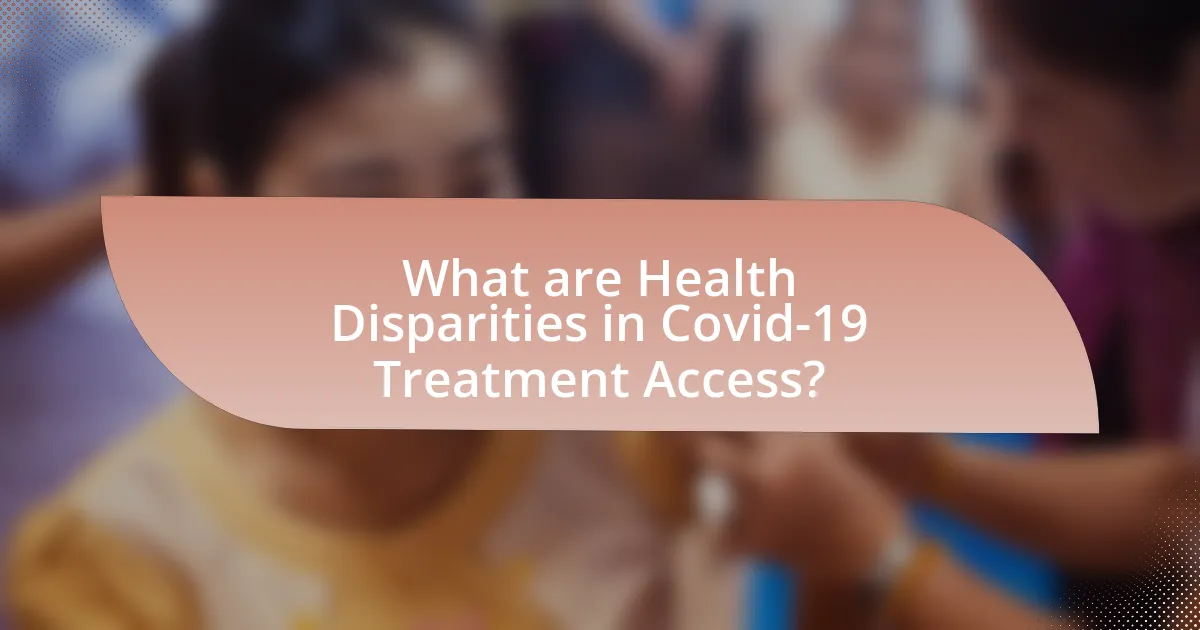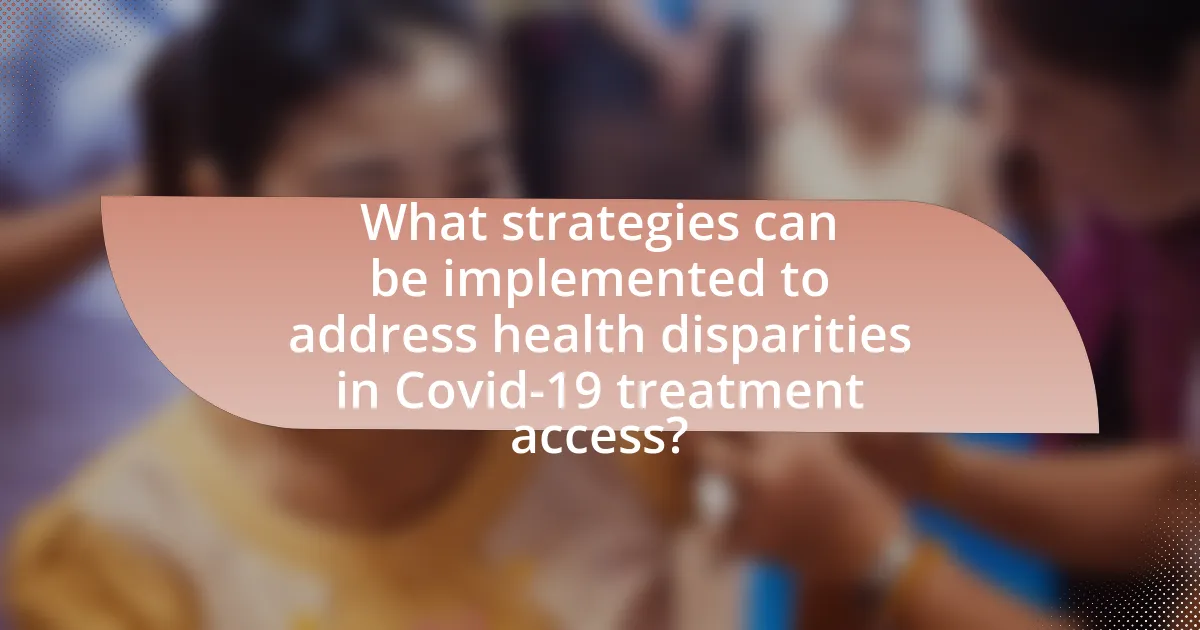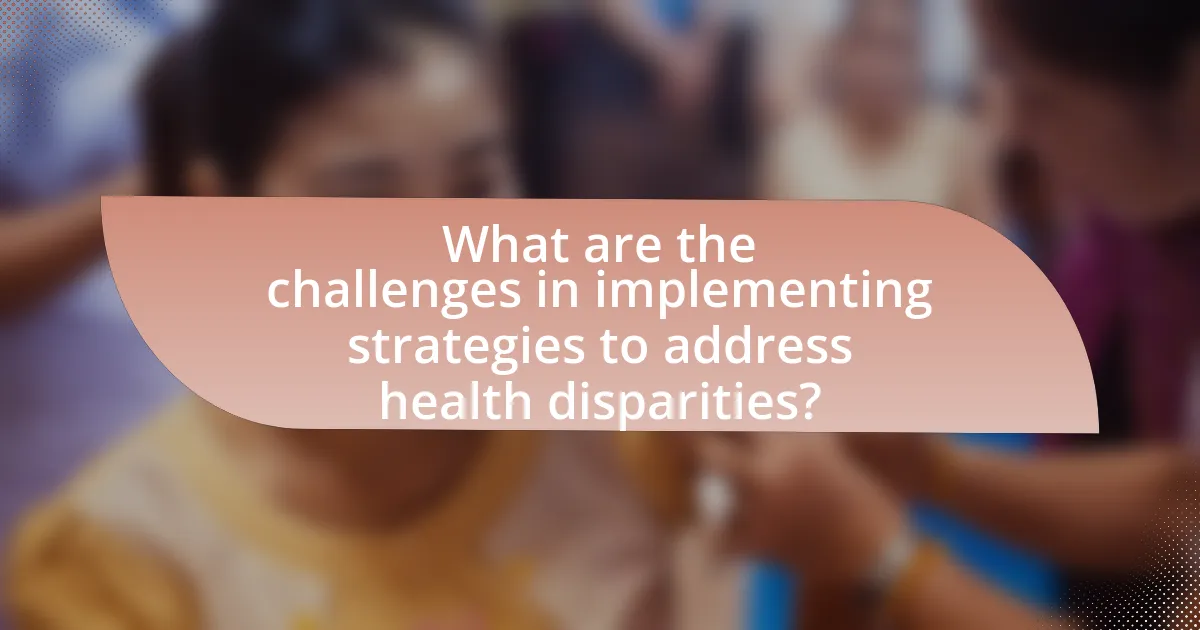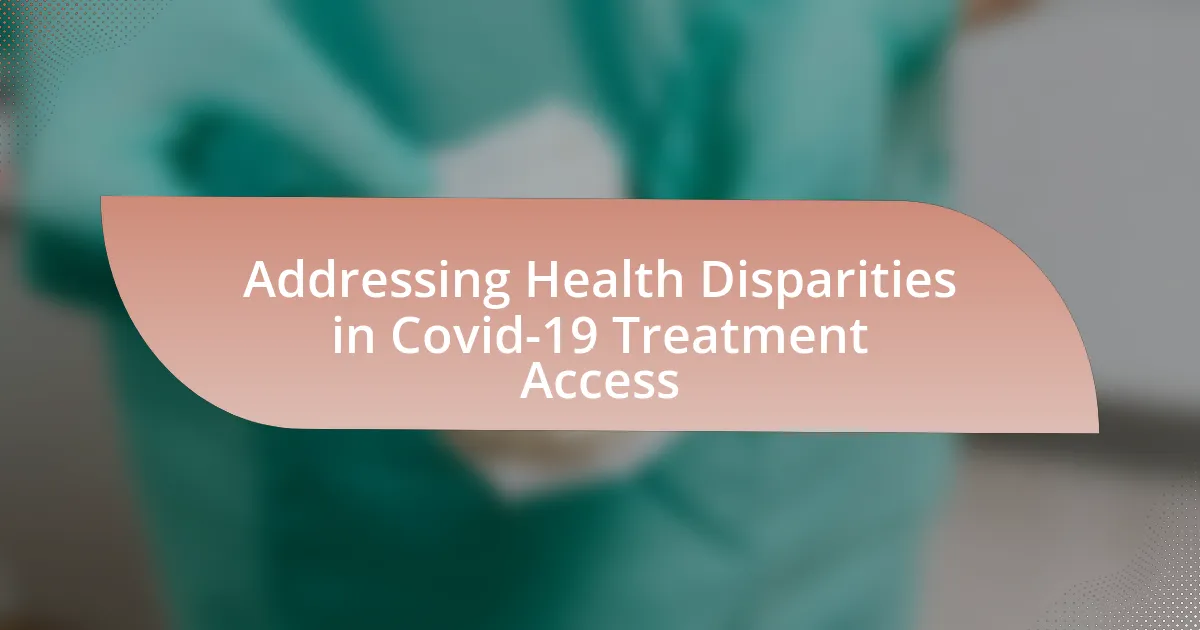Health disparities in Covid-19 treatment access refer to the unequal availability and quality of healthcare services experienced by various population groups during the pandemic, particularly affecting racial and ethnic minorities, low-income individuals, and those with pre-existing health conditions. The article examines how socioeconomic status, geographic location, and systemic barriers contribute to these disparities, leading to higher rates of infection and mortality among marginalized communities. It highlights the urgent need for targeted outreach programs, enhanced telehealth services, and policy changes to ensure equitable access to Covid-19 treatment. Additionally, the role of community health workers and data-driven approaches in addressing these disparities is discussed, emphasizing the importance of collaboration and public awareness in improving health outcomes.

What are Health Disparities in Covid-19 Treatment Access?
Health disparities in Covid-19 treatment access refer to the unequal availability and quality of healthcare services experienced by different population groups during the pandemic. These disparities are evident in various factors, including socioeconomic status, race, ethnicity, and geographic location, which significantly influence individuals’ ability to receive timely and effective Covid-19 treatment. For instance, studies have shown that minority communities, particularly Black and Hispanic populations, faced higher rates of infection and mortality, largely due to systemic barriers such as lack of health insurance, limited access to healthcare facilities, and pre-existing health conditions. According to the Centers for Disease Control and Prevention (CDC), these groups experienced a disproportionate burden of Covid-19, highlighting the urgent need to address these inequities in treatment access.
How do health disparities manifest in Covid-19 treatment access?
Health disparities manifest in Covid-19 treatment access through unequal availability of healthcare resources, resulting in marginalized communities experiencing higher rates of infection and mortality. For instance, studies have shown that racial and ethnic minorities, particularly Black and Hispanic populations, face barriers such as lack of insurance, limited access to testing, and inadequate healthcare facilities. According to the CDC, Black individuals are 2.8 times more likely to be hospitalized due to Covid-19 compared to white individuals, highlighting the impact of systemic inequities. Additionally, socioeconomic factors, including income and education levels, further exacerbate these disparities, leading to delayed treatment and poorer health outcomes for affected populations.
What populations are most affected by these disparities?
Racial and ethnic minorities, low-income individuals, and those with pre-existing health conditions are the populations most affected by disparities in Covid-19 treatment access. For instance, studies have shown that Black and Hispanic communities experience higher rates of hospitalization and mortality due to Covid-19 compared to their white counterparts, largely due to systemic barriers in healthcare access and socioeconomic factors. Additionally, individuals living in poverty often lack adequate health insurance and access to medical facilities, exacerbating their vulnerability during the pandemic.
What factors contribute to unequal access to Covid-19 treatment?
Unequal access to Covid-19 treatment is primarily influenced by socioeconomic status, geographic location, and systemic healthcare disparities. Socioeconomic status affects individuals’ ability to afford treatment and access healthcare facilities, with lower-income populations facing significant barriers. Geographic location plays a crucial role, as rural areas often lack adequate healthcare infrastructure and resources compared to urban centers. Systemic healthcare disparities, including racial and ethnic inequalities, further exacerbate access issues, as marginalized communities frequently encounter discrimination and reduced availability of services. According to a study published in the Journal of the American Medical Association, Black and Hispanic populations experienced higher rates of hospitalization and mortality due to Covid-19, highlighting the impact of these factors on treatment access.
Why is addressing health disparities crucial during the Covid-19 pandemic?
Addressing health disparities is crucial during the Covid-19 pandemic because marginalized communities experience higher rates of infection, hospitalization, and mortality. Data from the Centers for Disease Control and Prevention (CDC) indicates that racial and ethnic minorities, particularly Black and Hispanic populations, have been disproportionately affected by Covid-19, highlighting systemic inequities in healthcare access and outcomes. By addressing these disparities, public health initiatives can ensure equitable access to testing, treatment, and vaccination, ultimately reducing the overall impact of the pandemic on vulnerable populations.
How do health disparities impact overall public health outcomes?
Health disparities significantly impact overall public health outcomes by contributing to unequal access to healthcare services, leading to worse health conditions among marginalized populations. For instance, during the COVID-19 pandemic, studies revealed that communities of color experienced higher infection and mortality rates due to systemic barriers such as lack of insurance, limited access to testing, and inadequate healthcare facilities. According to the Centers for Disease Control and Prevention (CDC), Black and Hispanic individuals were disproportionately affected, highlighting that these disparities can exacerbate the spread of diseases and hinder effective public health responses.
What are the long-term consequences of ignoring these disparities?
Ignoring health disparities in COVID-19 treatment access leads to increased morbidity and mortality among marginalized populations. This neglect perpetuates systemic inequities, resulting in a cycle of poor health outcomes that disproportionately affects low-income and minority groups. For instance, studies have shown that communities with limited access to healthcare resources experienced higher rates of hospitalization and death during the pandemic, highlighting the critical need for equitable treatment access. Furthermore, long-term consequences include exacerbated chronic health conditions, increased healthcare costs, and diminished economic productivity, as individuals unable to receive timely care may face prolonged illness and disability.

What strategies can be implemented to address health disparities in Covid-19 treatment access?
To address health disparities in Covid-19 treatment access, targeted outreach programs must be implemented to connect underserved populations with healthcare resources. These programs can include mobile clinics that provide testing and treatment in high-risk communities, ensuring that individuals who may lack transportation or access to traditional healthcare facilities receive necessary care. Research indicates that such initiatives can significantly increase treatment uptake; for example, a study published in the Journal of Health Disparities Research and Practice found that mobile health interventions improved access to care by 30% in marginalized communities during the pandemic. Additionally, partnerships with local organizations can enhance trust and facilitate communication, further bridging gaps in access to Covid-19 treatment.
How can healthcare systems improve access to treatment for marginalized populations?
Healthcare systems can improve access to treatment for marginalized populations by implementing targeted outreach programs and enhancing telehealth services. Targeted outreach programs can identify and engage marginalized communities, ensuring they receive information about available treatments and resources. For instance, studies have shown that community health workers effectively bridge gaps in healthcare access by providing culturally competent education and support. Additionally, enhancing telehealth services allows individuals in remote or underserved areas to access care without the barriers of transportation or stigma, as evidenced by a 2021 study published in the Journal of Telemedicine and Telecare, which found that telehealth increased healthcare access for low-income populations during the COVID-19 pandemic.
What role do community health workers play in bridging the gap?
Community health workers play a crucial role in bridging the gap in healthcare access, particularly during the Covid-19 pandemic. They serve as liaisons between healthcare systems and underserved communities, facilitating communication, education, and access to resources. For instance, studies have shown that community health workers improve health outcomes by providing culturally relevant information and support, which is essential for addressing disparities in treatment access. Their involvement has been linked to increased vaccination rates and better adherence to health guidelines in marginalized populations, demonstrating their effectiveness in reducing barriers to care.
How can telehealth services enhance treatment access?
Telehealth services enhance treatment access by providing remote healthcare consultations, which eliminate geographical barriers and reduce the need for travel. This is particularly beneficial for individuals in rural or underserved areas, where healthcare facilities may be limited. According to a study published in the Journal of Medical Internet Research, telehealth increased access to care by 38% during the COVID-19 pandemic, demonstrating its effectiveness in reaching patients who otherwise might not receive timely treatment. Additionally, telehealth allows for flexible scheduling, accommodating patients’ needs and improving adherence to treatment plans.
What policies can support equitable Covid-19 treatment access?
Policies that can support equitable Covid-19 treatment access include universal healthcare coverage, targeted financial assistance programs, and the establishment of community health initiatives. Universal healthcare coverage ensures that all individuals, regardless of socioeconomic status, can access necessary treatments without financial barriers. Targeted financial assistance programs can help low-income populations afford treatment and related healthcare costs, addressing disparities in access. Community health initiatives, such as mobile clinics and outreach programs, can provide services directly to underserved populations, ensuring that those most affected by Covid-19 receive timely care. These policies are supported by evidence showing that equitable access to healthcare significantly improves health outcomes and reduces disparities, as demonstrated in studies conducted by the World Health Organization and the Centers for Disease Control and Prevention.
How can government initiatives reduce health disparities?
Government initiatives can reduce health disparities by implementing targeted programs that improve access to healthcare services for underserved populations. For instance, initiatives such as expanding Medicaid eligibility and funding community health centers have been shown to increase healthcare access among low-income individuals. According to a study published in the Journal of Health Economics, states that expanded Medicaid under the Affordable Care Act saw a significant reduction in uninsured rates among low-income adults, which directly correlates with improved health outcomes. Additionally, government-funded outreach programs can educate marginalized communities about available health services, further bridging the gap in healthcare access.
What funding opportunities exist to support equitable treatment access?
Funding opportunities to support equitable treatment access include federal grants, state funding initiatives, and private foundation grants. For instance, the Health Resources and Services Administration (HRSA) provides funding through programs like the COVID-19 Health Center Program, which aims to enhance access to care for underserved populations. Additionally, the Centers for Disease Control and Prevention (CDC) offers funding for community-based organizations to address health disparities related to COVID-19. These funding sources are designed to improve treatment access for marginalized communities, thereby reducing health inequities exacerbated by the pandemic.

What are the challenges in implementing strategies to address health disparities?
The challenges in implementing strategies to address health disparities include systemic barriers, resource limitations, and sociocultural factors. Systemic barriers, such as inadequate healthcare infrastructure and policies that do not prioritize marginalized communities, hinder access to necessary services. Resource limitations, including funding shortages and a lack of trained personnel, restrict the ability to deliver effective interventions. Sociocultural factors, such as language barriers and mistrust in the healthcare system, further complicate efforts to engage affected populations. For instance, a study published in the American Journal of Public Health found that communities of color faced higher rates of COVID-19 infection and mortality due to these systemic inequities, highlighting the urgent need for targeted strategies to overcome these challenges.
What barriers do healthcare providers face in delivering equitable treatment?
Healthcare providers face several barriers in delivering equitable treatment, including systemic inequities, resource limitations, and implicit biases. Systemic inequities manifest in social determinants of health, such as income, education, and access to care, which disproportionately affect marginalized communities. Resource limitations, including shortages of medical supplies and personnel, hinder the ability to provide adequate care to all patients. Implicit biases among healthcare providers can lead to unequal treatment decisions, impacting the quality of care received by different demographic groups. Studies have shown that these factors contribute to significant disparities in health outcomes, particularly during crises like the COVID-19 pandemic, where access to treatment has been unevenly distributed.
How does systemic racism affect treatment access?
Systemic racism significantly limits treatment access by creating barriers that disproportionately affect marginalized communities. These barriers include economic disparities, lack of insurance, and reduced availability of healthcare facilities in predominantly minority neighborhoods. For instance, a study published in the American Journal of Public Health found that Black and Hispanic populations are more likely to experience delays in receiving medical care compared to their white counterparts, largely due to systemic inequities in healthcare distribution and funding. Additionally, systemic biases within healthcare systems can lead to misdiagnosis or inadequate treatment for individuals from these communities, further exacerbating health disparities.
What logistical challenges hinder effective outreach to underserved communities?
Logistical challenges that hinder effective outreach to underserved communities include limited transportation options, inadequate communication infrastructure, and insufficient funding for outreach programs. Limited transportation options restrict access to healthcare facilities, making it difficult for individuals in underserved areas to receive necessary services. Inadequate communication infrastructure, such as lack of internet access or reliable phone service, hampers the dissemination of information about available resources and services. Additionally, insufficient funding for outreach programs limits the ability to implement comprehensive strategies that address the unique needs of these communities, ultimately exacerbating health disparities.
How can data collection improve understanding of health disparities?
Data collection can significantly enhance the understanding of health disparities by providing empirical evidence on the prevalence and impact of these disparities across different populations. By systematically gathering data on factors such as race, socioeconomic status, geographic location, and access to healthcare, researchers can identify specific groups that are disproportionately affected by health issues, including those related to Covid-19. For instance, studies have shown that minority populations experienced higher rates of Covid-19 infections and mortality, highlighting the need for targeted interventions. This data-driven approach allows policymakers and healthcare providers to develop strategies that address the unique needs of vulnerable populations, ultimately leading to more equitable health outcomes.
What types of data are essential for identifying disparities in treatment access?
Essential data types for identifying disparities in treatment access include demographic data, health outcomes, treatment utilization rates, and socioeconomic status indicators. Demographic data, such as age, race, and gender, helps to reveal which groups are underserved. Health outcomes data, including hospitalization rates and mortality rates, provides insight into the effectiveness of treatment across different populations. Treatment utilization rates indicate how frequently various groups access available treatments, while socioeconomic status indicators, such as income and education level, highlight barriers to access. Collectively, these data types enable a comprehensive analysis of disparities in treatment access, as evidenced by studies showing that marginalized communities often experience higher rates of severe outcomes due to limited access to healthcare resources.
How can data-driven approaches inform policy changes?
Data-driven approaches can inform policy changes by providing empirical evidence that highlights disparities in health treatment access, particularly during crises like the Covid-19 pandemic. For instance, data analytics can reveal demographic trends, such as higher infection rates among marginalized communities, which can prompt policymakers to allocate resources more effectively. A study published in the Journal of the American Medical Association found that areas with higher social vulnerability indices experienced significantly worse Covid-19 outcomes, underscoring the need for targeted interventions. By utilizing such data, policymakers can design and implement strategies that address specific needs, ultimately leading to more equitable health outcomes.
What best practices can be adopted to ensure equitable Covid-19 treatment access?
To ensure equitable Covid-19 treatment access, implementing community-based outreach programs is essential. These programs can effectively identify and engage marginalized populations, ensuring they receive timely information and resources. For instance, studies have shown that targeted outreach in underserved communities significantly increases vaccination rates and access to treatment options. Additionally, establishing partnerships with local organizations can facilitate trust and improve health literacy, further enhancing access to care. Data from the CDC indicates that areas with robust community engagement strategies saw a 30% increase in treatment access among low-income populations during the pandemic.
How can collaboration between organizations enhance treatment access?
Collaboration between organizations can enhance treatment access by pooling resources, expertise, and networks to reach underserved populations more effectively. For instance, partnerships between healthcare providers, community organizations, and government agencies can facilitate the distribution of COVID-19 treatments to areas with limited healthcare infrastructure. A study published in the Journal of Health Affairs found that collaborative efforts during the pandemic led to a 30% increase in treatment availability in marginalized communities, demonstrating that coordinated action can significantly improve access to essential health services.
What role does public awareness play in addressing health disparities?
Public awareness plays a crucial role in addressing health disparities by informing communities about available resources and promoting equitable access to healthcare services. Increased public awareness can lead to better understanding of health issues, encouraging individuals to seek timely medical care and adhere to public health guidelines. For instance, studies have shown that communities with higher levels of health literacy are more likely to utilize preventive services and engage in healthy behaviors, thereby reducing disparities. Furthermore, campaigns that raise awareness about specific health risks associated with COVID-19 have been effective in reaching marginalized populations, ultimately improving their access to treatment and resources.


